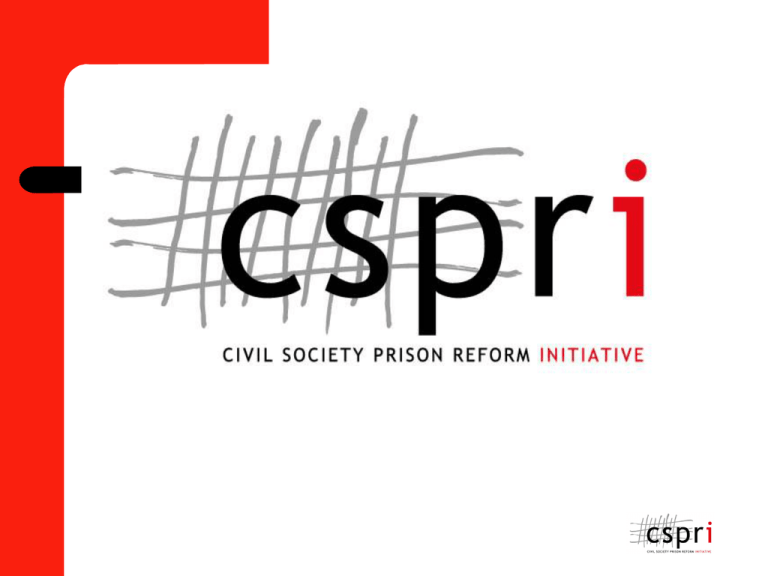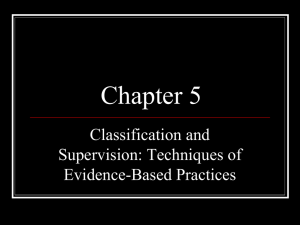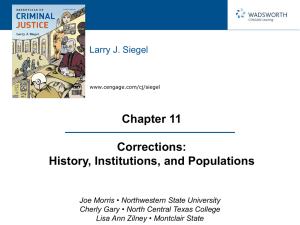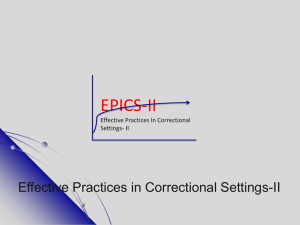Alternative Sentencing
advertisement

CSPRI PRESENTATION TO THE PORTFOLIO COMMITTEEE ON CORRECTIONAL SERVICES 1 NOV 2005 ALTERNATIVE SENTENCING Introduction International law Domestic law Case law Problems and challenges Introduction (cont.) Zvekic argues: The arguments for non-custodial sanctions are essentially the mirror image of the arguments against imprisonment. First, they are considered more appropriate for certain types of offences and offenders. Second, because they avoid ‘prisonisation’, they promote integration back into the community as well as rehabilitation, and are therefore more humane. Third, they are generally less costly than sanctions involving imprisonment. Fourth, by decreasing the prison population, they ease prison overcrowding and thus facilitate administration of prisons and the proper correctional treatment of those who remain in prison. U. Zvekic, “International Trends in Non-Custodial Sanctions” (in Promoting Probation Internationally, Publication No. 85, UNICRI, Rome, 1997) p 23. International Law UN Standard Minimum Rules for Non-Custodial Measures (Tokyo Rules) were adopted by General Assembly resolution 45/110 of 14 December 1990 Should be read together with all other international instruments to ensure dignity and prevent the imposition of cruel, inhuman and degrading treatment and punishment (UNCAT) Non-custodial measures may not be cruel, inhuman or degrading corporal punishment Sentence must assist the convicted person not to commit another offence International Law (cont.) The Tokyo Rules provide for the following sentencing options: – – – – – – – – – – – – – Verbal sanctions, such as admonition, reprimand and warning Conditional discharge Status penalties Economic sanctions and monetary penalties, such as fines and day-fines Confiscation or an expropriation order Restitution to the victim or a compensation order Suspended or deferred sentence Probation and judicial supervision A community service order Referral to an attendance centre House arrest Any other mode of non-institutional treatment Some combination of the measures listed above. Domestic legislation According to the Criminal Procedure Act no. 51 of 1977 the following non- custodial sentences are available: S 276(1)(h) (read with S 276A) provides for a sentence to correctional supervision not exceeding 3 years. This sentence is served entirely at home, with no period of imprisonment. A report is required from a correctional official or a probation officer prior to sentence being passed, and the sentence is available in respect of any offence. S 276(1)(i) (read with S 276A) provides for a sentence of imprisonment not exceeding 5 years, from which such a person may be placed under correctional supervision at the discretion of the Commissioner. A report is required from a correctional official or a probation officer prior to sentence being passed, and the sentence is available in respect of any offence. Domestic legislation (cont.) S 276A(3)(a) provides that in the case of a prisoner who has been sentenced to less than 5 years (or his or her release date is less than 5 years in the future) the Commissioner may, if he is of the opinion that such a person is fit to be subjected to correctional supervision, apply to the clerk or registrar of the court, as the case may be, to have that person appear before the court a quo in order to reconsider said sentence. The court has an option to convert the sentence into correctional supervision on the conditions it may deem fit. S 287(4)(a) deals with the situation of where a person has been sentenced to pay a fine with an alternative of imprisonment not exceeding 5 years, and such person is unable to pay the fine. Upon the start of the imprisonment or any time thereafter the Commissioner has the discretion (unless the court directed otherwise at the time of passing sentence) to convert the sentence into correctional supervision, as if the sentence had been imprisonment as referred to in s 276(1)(i), or to make an application to the court a quo following the procedure set out in section 276A(3). Domestic legislation (cont.) S 287 (4) (b) deals with a situation where a person has been sentenced to pay a fine with an alternative of imprisonment not exceeding 5 years, and such person is unable to pay the fine. The matter may be referred back to the court a quo to set a new sentence of correctional supervision. S 290 provides for a person under the age of 18 years to be placed under the supervision of a probation officer or a correctional official for a period of two years. S 296 allows the court, in addition to or in lieu of any sentence (but not in addition to a sentence of imprisonment), to order that the person be detained in a treatment centre established under the Prevention and Treatment of Drug Dependency Act, 1992. Domestic legislation (cont.) S 297 makes provision for the conditional or unconditional postponement or suspension of sentence, and caution or reprimand. These apply to all offences other than those for which a minimum sentence is prescribed. The conditions that are included are – compensation – the rendering of a specific benefit or service in lieu of compensation – the performance without remuneration and outside the prison of some service for the benefit of the community – submission to correctional supervision – submission to instruction or treatment – submission to the supervision or control of a probation officer – compulsory attendance or residence at some specified centre for a specified purpose – good conduct – any other matter. Domestic legislation (cont.) If the sentence is postponed with conditions, a court must be satisfied that the conditions have been observed, in which case the court shall discharge him or her without the passing of a sentence. If the sentenced is postponed unconditionally and the person has not been called to appear before the court again during the postponement period, such person is deemed to have been discharged. Section 300 provides that where a person is convicted of an offence that has caused damage to or loss of property (including money) belonging to some other person, the court may, upon the application of the victim or of the prosecutor acting on the instructions of the victim, forthwith award the injured person compensation for such damage or loss. Domestic legislation (cont.) To fully understand how these provisions work once the offender is serving his or her sentence in the community, they have to be read in conjunction with section 52 of the Correctional Services Act. Summarised, these sections deal with the following matters: – Section 52 provides that every probationer shall be subject to such monitoring, community service, house arrest, placement in employment, performance of service, payment of compensation to the victim and rehabilitation or other programmes as determined by the Court or the Commissioner, and to any other form of treatment, control or supervision, including supervision by a probation officer after consultation with the social welfare authority concerned. – Section 70 says that if the Commissioner is satisfied that a probationer has failed to comply with any condition he may issue a warrant for the arrest of such probationer, which serves as authorisation for detention of such probationer in a prison until he is lawfully discharged or released, placed under correctional supervision again, or referred back to court with 72 hours for trial or to put into operation any suspended or postponed sentence. Domestic legislation (cont.) S 52 lists the kind of programmes that the probationer can be involved with, these are observation or supervision community service compensation to victims reintegration back into the community rehabilitation collection of funds, including the costs arising from the execution of the sentence any other matter considered necessary or expedient. These sections clearly visualized a partnership between the Departments of Correctional Services and Social Development as well as with non-governmental organisations, as mention is made several times to working together with “any social welfare authority or other body”. – Domestic legislation (cont.) The Criminal Procedure Act provides a set of sentencing tools that is both broad and flexible. – – Firstly, section 276A (3)(a) and section 287(4)(b) allow the judicial officer to change his or her own sentence, which is contrary to the general rule of sentencing. Usually judicial officers cannot substitute or change their own sentences; the Criminal Procedure Act only allows errors to be corrected immediately after they have been made. Section 276A also allows a judicial officer to change the sentence of another judicial officer, because it gives this power to “a court, whether constituted differently or not.” Secondly, whilst sections 276A (3)(a) and section 287(4)(b) give discretion to the Commissioner of Correctional Services to put matters back on the court roll, section 287(4)(a) goes even further, giving the Commissioner the discretion, in relation to cases where a person is in prison because of failure to pay a fine, to make a decision to convert the sentence to one of correctional supervision without taking the matter back to court. Domestic legislation (cont.) – The other remarkable point about these provisions is that they are not linked to categories of offences. This discretion has been affected, of course, by the introduction of minimum sentences brought about by the Criminal Law Amendment Act no. 105 of 1997 (MSL) SA case law Community service as a sentence was at issue in S v Abrahams in 1990 and Judge Conradie held that community service is not a sanction that can only be applied as a sentence for less serious offences. S v Mogara in 1990 determined that a sentence of community service need not berestricted to first-time offenders. In 1991, S v Russouw found that although community service is “a valuable weapon in the fight against crime” it was not normally appropriate for offenders suffering from some or other form of personality disturbance or for recidivists. On the facts of the case the court found that community service was not suitable for a second offender who had been convicted of theft and fraud relating to a large amount of public money. In the case of S v De Bruin, the court declined to sentence an offender with three relevant previous convictions to community service. SA case law (cont) In S v Miners, the court declined the use of community service on the grounds that the offender was aggressive and uncooperative. In S v Van Vuuren, however, the court applied correctional supervision for a female first offender that had stolen over R73 000 from her employer, a bank. In 1994, S v Sikhunyana established that a proper investigation into all relevant issues was essential in determining whether community service was appropriate and that although there were administrative and practical difficulties associated with carrying out community service, Courts should not allow themselves to be unduly hamstrung by such difficulties. In 1994, the Constitutional Court struck down the sentence of corporal punishment in S v Williams, in which Justice Langa reviewed the range of sentencing options available on the statute books. SA case law (cont) S v Stanley - In this case, it was found that courts must take care when handing down a sentence in terms of section 276 (1) (i) not to set any measures that would interfere with the discretion of the Commissioner of Correctional Services – and in particular that the total period of the sentence must not exceed 5 years. The discretion of the Commissioner of Correctional Services was also under the spotlight in Roman v Williams NO, which tested the constitutionality of the Commissioner’s power to reimprison a probationer in terms of section 84B(1) of the Correctional Services Act no. 8 of 1959. The court found that this power was in line with the Constitution, because it was necessary to preserve the “crucial penal character” of correctional supervision, and to maintain public respect for this sentence as an effective punishment and deterrent. SA case law (cont) The Appellate Division matter of S v R decided that correctional supervision was an appropriate sentence for a man convicted of a sexual offence involving a 15-year-old boy, despite the man having a relevant previous conviction. This is because a sentence in terms of section 276 (1) (h) allowed him to obtain the necessary therapeutic support he needed. The court found that the sentence was particularly suitable, because the offender was young (32 years old), had strong family ties and a stable work pattern. His criminality had its origins in personality defects that responded favourably to therapy, whereas imprisonment would have had a negative impact on these defects and would interrupt the therapy. A similar approach was evident in another judgment handed down by the Appellate Division later in the same year. SA case law (cont) S v Williams established that sentencing involving rehabilitative treatment such as treatment of drug addiction would have much greater success if the offender remained in the community, where he could continue being employed and living with his family. Thus the matter was referred to correctional supervision for conversion after due compliance with the provisions of Section 276 A (1)(a). The principles relating to the sentencing of a child offender were expounded on in S v Kwalase. The court found that the magistrate had erred in not asking for a pre-sentence report. The SCA in S v Mc Millan, the court set aside a ten-year term of imprisonment and replaced it with a sentence of imprisonment for five years in terms of section 276(1)(i) of the Criminal Procedure Act. The court based its decision on the principle of consistency. It found that although the offence was considered serious (indecent assault on three young boys), the sentence was too severe in comparison to sentences handed down in equivalent cases that had been confirmed on appeal. Can Non-custodial sentences reduce the prison population? Look at the sentence profile of the SA prison population We have seen a decrease in the number of people being admitted to serve prison terms but they are staying there for much longer: – 2002 = 193 901 – 2003 = 181 355 – 2004 = 169 756 Unsentenced prison population is dropping steadily Can Non-custodial sentences reduce the prison population? (cont) Sentence 0-6 Months >6-12 Months >12-<24 Months 2-3 Years >3-5 Years >5-7 Years >7-10 Years >10-15 Years >15-20 Years >20 Years to Life Other Sentenced Total Sentenced Number Percentage Category 5783 4.2 6160 4.5 13.1 6121 4.4 18511 13.5 25.9 17111 12.4 12349 9.0 21494 15.6 22957 16.7 10534 7.7 50.8 14929 10.8 1652 1.2 137601 Description 0-24 Months 2 - 5 years 7+years Overview and challenges The legislative framework is more than sufficient Lack of infrastructure (vehicles etc) Lack of human resources – pre-sentence reports and monitoring Lack of encouragement Lack of knowledge and understanding of options Performance indicators for magistrates and prosecutors (delays) Poor inter-sectoral cooperation Future Increase allocation to community corrections in the DCS budget – 2005/6 allocation (After care programme) is 3.7% of total budget, next year it will be 3.6% (increase of 5.2%) according to ENE whilst total budget increases by 6.56% Place pressure on judiciary to use non-custodial measures for short term imprisonment (under 24 months) end







